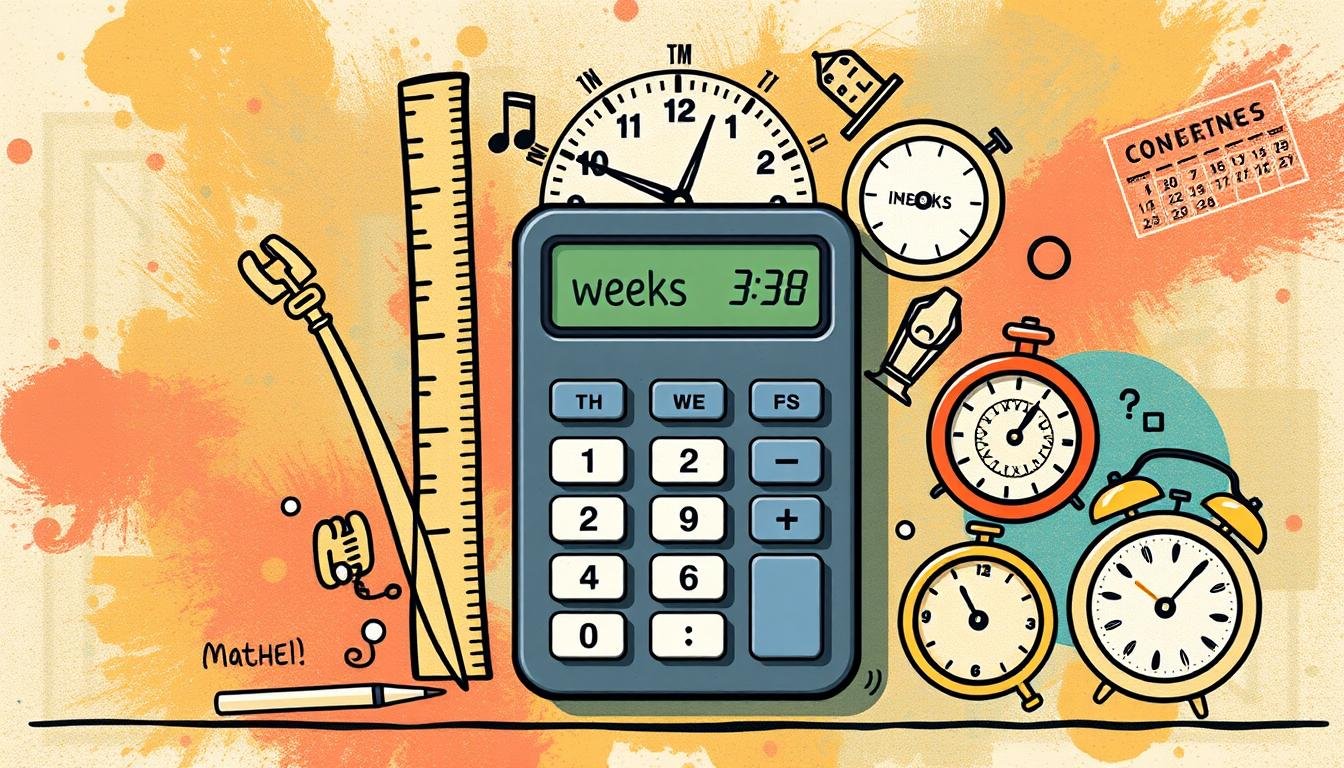“An illustrated conversion chart depicting the relationship between weeks and months, featuring a clean layout with visually distinct sections for each time frame, using vibrant colours and engaging icons representing time, such as clocks and calendars, set against a modern background.”
Time calculation can change how we plan our schedules. Weeks-to-month conversion is key for tracking timelines.
It helps with work projects, pregnancy milestones, and long-term goals. Accurate conversions make planning easier.
Time management needs precise measurements. Converting weeks to months breaks down complex schedules.
Our guide will show you how to do this. It makes time tracking simple.
Different situations need different time calculation methods. This skill helps in business and personal growth.
You’ll learn tools to master time conversions quickly. These techniques will boost your planning skills.
Many professionals value accurate time tracking. This skill improves organization and timeline communication.
Understanding the Basics of Weeks and Months
Time is a key part of human life. Calendar systems help us measure and grasp periods.
Weeks and months are two primary time units. They help us plan our daily lives and tasks.
A week has seven days. A month has 28 to 31 days.
Weekly and monthly measurements affect how we plan tasks. Each unit serves different purposes in our lives.
Old cultures made ways to track time. Calendar systems grew to meet society’s needs.
The Gregorian calendar is used worldwide. It sets how we see and split time.
Weeks give a short-term view. Months offer a broader look at time passing.
People gain from knowing how to use these time units. It helps in work and personal life.
The Standard Conversion Rate
Converting weeks to months uses a simple formula. One month is about 4.3 weeks, which helps with quick changes.
To change weeks to months, multiply weeks by 0.23. For example, 10 weeks equals about 2.3 months.
Remember that months can vary in length. The 4.3-week rule is a good guide for most cases.
Different jobs may need more exact time counts. Project managers often use this method for easy scheduling.
This formula helps people plan better. It makes talking about time easier at work and in life.
Practical Applications of Week-to-Month Conversion
Week-to-month conversion is key in many areas. Project planners use it to manage deadlines and resources better.
Managers break down complex timelines into smaller parts. This helps them track progress more efficiently.
Financial experts use time conversion for budgeting. It helps them create more accurate plans.
Investors use precise time measurements to predict returns. They also use it to make long-term investment plans.
Doctors often convert weeks to months for pregnancy tracking. This helps monitor baby growth and plan care.
Research teams benefit from time conversions, too. It gives them a clear view of project length.
People use these skills for personal projects. It helps set realistic goals for home fixes or fitness.
Tools and Resources for Conversion
“An artistic representation of a calculator with weeks and months symbols, surrounded by illustrated tools like a ruler, a clock, and a calendar, set against a vibrant, abstract background that suggests time and conversion.”
Digital tech offers many ways to convert weeks to months quickly. Online calculators are key tools for fast and accurate time calculations.
These web tools let users input weeks and get months instantly. Mobile apps also make week-to-month conversions easy.
Smartphone apps for time tracking offer seamless conversions. Many apps include features like date tracking and project management.
Spreadsheet formulas are great for pros and data analysts. Excel and Google Sheets have functions that change weeks into months.
Users can make custom calculations for specific projects. Online calculators like TimeCalc and DateConverter are user-friendly.
These platforms support multiple time units and give precise results. Most online calculators are free and work on various devices.
Project management software also includes powerful time conversion tools. These systems help teams track time and manage deadlines easily.
How to Calculate Weeks to Months Manually
Convert weeks to months without digital calculators. An average month has about 4.3 weeks.
Multiply the number of weeks by 0.23 for a quick estimate. For example, 10 weeks is roughly 2.3 months.
To convert weeks to months, follow these steps:
– Count the total weeks – Multiply by 0.23 – Round to the nearest tenth – Check against a calendar
Practice makes perfect. Remember that 4 weeks is about one month.
Keep in mind that calendar months vary slightly. Double-check necessary time-sensitive calculations for accuracy.
Why Accurate Conversions Matter
Precise planning can make or break project success. Time-sensitive decisions need careful math and close attention.
Minor errors in week-to-month conversions can cause big problems. These issues can affect both work and personal life.
Avoiding mistakes is key when working on complex projects. Wrong time frames can lead to missed deadlines and budget issues.
Exact scheduling is vital for project timelines. Managers use precise time math to guide team efforts.
Financial planning also needs accurate time conversion. Investment plans and loan terms rely on careful time tracking.
Time conversion skills are a big plus in many jobs. A sound system for tracking time helps cut risks.
Frequently Asked Questions (FAQs)
Time calculation can be tricky. Our FAQs answer common questions about converting weeks to months.
Q: How many weeks are in a month exactly? A: An average month has about 4.3 weeks. This helps simplify time tracking for planning.
Q: Can I use a standard conversion rate for all months? A: Not exactly. Months have 28 to 31 days, and week calculations aren’t always the same.
Q: Why do conversion queries differ between calendars? A: Different calendar systems affect week and month calculations. Lunar, solar, and Gregorian calendars can give slightly different results.
Q: Are online conversion tools reliable? A: Most online calculators give accurate results. Double-check essential calculations to be sure.
Q: What’s the easiest way to convert weeks to months? A: Multiply weeks by 0.23 for a quick estimate. For exact results, use a calendar or tool.
Conclusion: Simplifying Time Management
Changing weeks to months can make planning easier. This skill helps you set goals and be more productive.
Knowing how to measure time improves planning skills. This helps with projects, goals, and busy schedules.
You can use digital tools or do the math yourself. Practice these methods to make better time choices.
Being flexible is key when working with time. Knowing weeks and months well helps you stay organized.
This skill will make you better at handling your tasks. You’ll feel more sure about your plans.
FAQ
How many weeks are in a month?
A month has about 4.3 weeks on average. This can change based on the month’s length.
Some months have 30 or 31 days. February is shorter than other months.
Is there a simple way to convert weeks to months?
Yes! Just divide the number of weeks by 4.3. This method works well for quick calculations.
For example, 8.6 weeks divided by 4.3 equals about 2 months.
Do different types of months affect the conversion?
Yes, they do. Calendar months can have 28 to 31 days.
A lunar month is about 4.29 weeks long. A standard calendar month averages 4.3 weeks.
Why do I need to convert weeks to months?
Converting weeks to months helps in many areas, including project planning, pregnancy tracking, and financial calculations.
It makes long-term planning more straightforward to understand and manage.
Are there any online tools to help with week-to-month conversions?
Yes, many online calculators and apps can quickly convert weeks to months.
Google Calculator, conversion.org, and spreadsheet programs like Excel offer this feature.
How do pregnancy weeks typically translate to months?
In pregnancy, 4 weeks usually equals 1 month. A full-term pregnancy is about 40 weeks or 9 months.
Doctors often use weeks to measure pregnancy more precisely.
What’s the most precise way to convert weeks to months?
For best results, multiply weeks by 7 to get days. Then divide by 30.44, the average month length.
This method accounts for different month lengths. It gives a more accurate conversion.
you may also read : How Many Seconds in a Month: Quick Time Calculation


